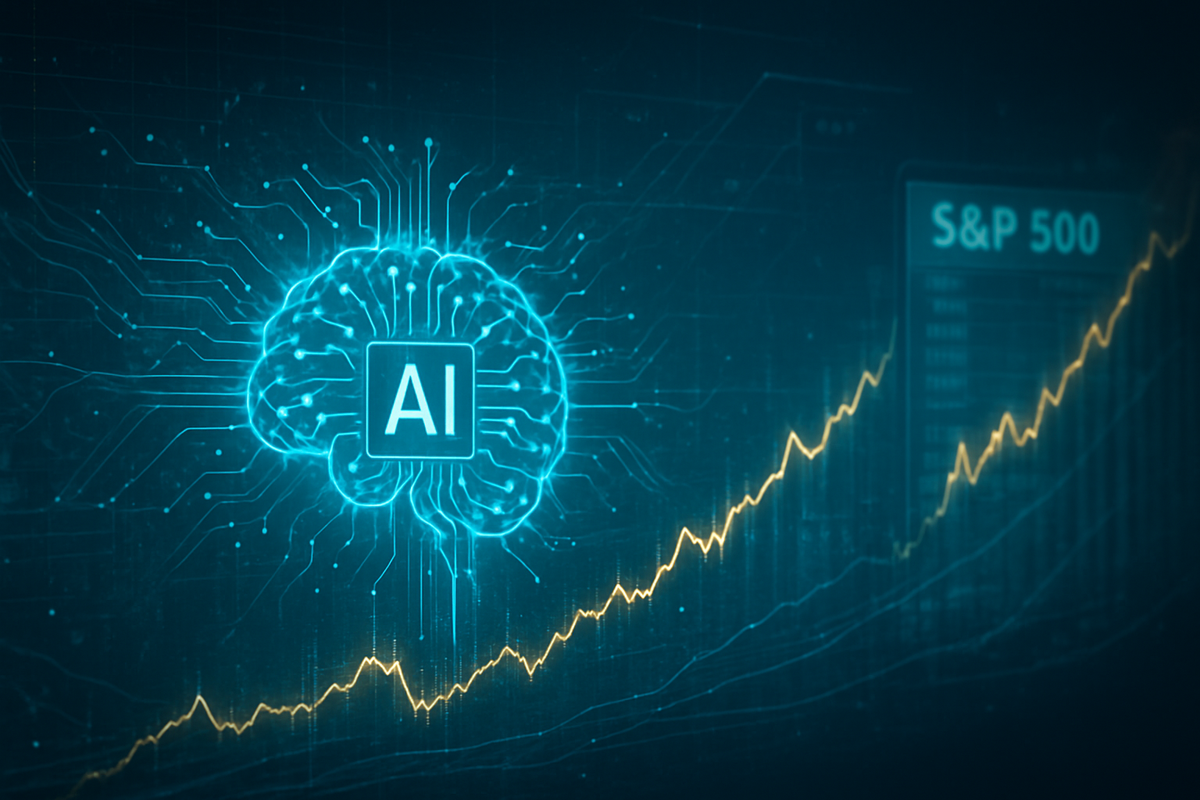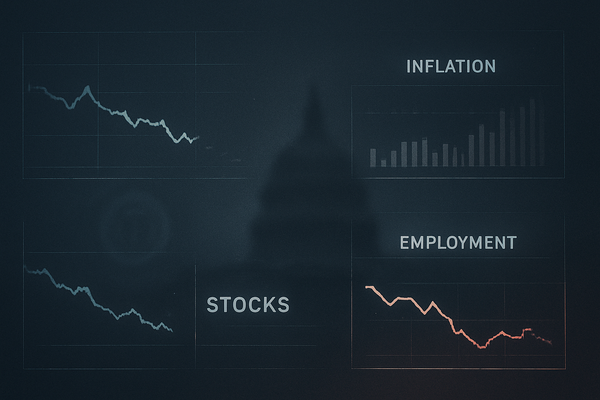AI Optimism Fuels Tech Sector's S&P 500 Surge Amidst Valuation Concerns

As November 10, 2025, unfolds, the Technology sector within the S&P 500 continues to be a dominant force in the market, largely propelled by an unrelenting wave of optimism surrounding Artificial Intelligence (AI). While precise real-time market figures for today are still emerging, the prevailing sentiment points towards a sector experiencing robust growth, driven by significant advancements and widespread adoption of AI technologies. This pervasive AI-driven enthusiasm has not only reshaped investor expectations but also spurred unprecedented capital allocation, positioning the technology giants at the forefront of market movements and presenting both immense opportunities and heightened risks for investors navigating this transformative era.
The immediate implications of this AI-centric rally are clear: a sustained focus on companies demonstrating leadership in AI development and integration, coupled with a vigilant eye on market valuations that have, in some instances, stretched to historic highs. The market is increasingly bifurcated between those poised to capitalize on the AI revolution and those struggling to adapt, making strategic investment choices more critical than ever.
The AI Buildout Boom: From Experimentation to Enterprise Integration
The period leading up to late 2025 has marked a pivotal transition for Artificial Intelligence, moving decisively from experimental pilot projects to becoming an indispensable component of enterprise strategy across various industries. This "AI buildout boom" is fundamentally reshaping the technology landscape, with a significant surge in global IT spending projected for 2025, primarily fueled by AI investments. By the third quarter of 2025, a remarkable 65% of companies are regularly leveraging generative AI (GenAI), a substantial leap from just 33% in 2023, underscoring the rapid pace of structural adoption. Technology companies, in particular, are leading this charge, with over 18% already utilizing AI to develop goods or services, more than double the rate observed in most other sectors. The focus has shifted from mere AI exploration to achieving tangible value, driving productivity gains, accelerating time-to-market, and boosting revenue.
A key driver of this market movement is the exponential expansion of Generative AI. Worldwide spending on GenAI is forecasted to reach an staggering $644 billion in 2025, representing a 76.4% increase from the previous year. This growth is attributed to continuous advancements in deep learning solutions, enhanced automation capabilities, and the compelling potential of GenAI to reduce operational costs while simultaneously augmenting productivity. Prominent enterprise software platforms, including Microsoft 365 Copilot (NASDAQ: MSFT), Salesforce Einstein GPT (NYSE: CRM), and Adobe Firefly (NASDAQ: ADBE), are integrating GenAI, fundamentally transforming workflows and unlocking new functionalities. Beyond enterprise applications, content creation stands out as a particularly fertile ground for generative AI's growth.
This burgeoning AI market has, in turn, ignited an insatiable demand for specialized hardware. Graphics Processing Units (GPUs), AI accelerators, and High-Bandwidth Memory (HBM) are now critical components, driving substantial revenue growth for chipmakers. Global revenue for GPUs and other AI accelerators used in data center AI infrastructure is expected to rise by approximately 67% in 2025. HBM revenue alone is projected to surge by up to 70% in 2025, potentially reaching $21 billion. This robust demand has prompted leading chip manufacturers like Taiwan Semiconductor Manufacturing Company (NYSE: TSM) to consistently raise their 2025 revenue forecasts, anticipating mid-30% annual growth.
However, amidst this wave of optimism, a growing chorus of concerns regarding an "AI bubble" has introduced increased market volatility and recent corrections in tech stocks. Analysts and banking executives have issued cautionary statements regarding potentially stretched valuations within the technology sector, particularly questioning the long-term return on investment for the immense capital being funneled into a select few AI-centric companies. This has periodically led to significant drops in benchmark indices like the Nasdaq Composite, signaling investor unease and a necessary recalibration of market expectations.
Companies Navigating the AI Frontier: Winners and Challengers
The profound influence of AI is creating a clear delineation between the potential winners and those facing significant challenges within the public markets. At the forefront of this AI-driven boom are the semiconductor giants that supply the foundational hardware. Companies like Nvidia (NASDAQ: NVDA), Advanced Micro Devices (NASDAQ: AMD), and Intel (NASDAQ: INTC) continue to experience robust performance, primarily fueled by the insatiable demand for their GPUs and AI accelerators. Taiwan Semiconductor Manufacturing Company (NYSE: TSM), as the world's largest contract chip manufacturer, is also a significant beneficiary, with its fabrication plants working overtime to produce the advanced silicon required for AI workloads. These companies are seeing their revenues soar, investing heavily in research and development to maintain their technological edge, and are crucial enablers of the entire AI ecosystem.
Cloud computing providers are also poised for substantial gains, as the computational power and data storage required for AI models necessitate massive cloud infrastructure. Hyperscalers such as Microsoft (NASDAQ: MSFT) with Azure, Amazon (NASDAQ: AMZN) with AWS, and Alphabet (NASDAQ: GOOGL) with Google Cloud are witnessing increased capital expenditures to expand their data centers and offer more sophisticated AI-as-a-service platforms. Their ability to provide scalable, on-demand AI resources makes them indispensable to businesses integrating AI. Furthermore, software companies that are successfully embedding generative AI into their core products are seeing renewed growth. Microsoft's Copilot integration into Microsoft 365, Salesforce's (NYSE: CRM) Einstein GPT, and Adobe's (NASDAQ: ADBE) Firefly are examples of how existing software suites are being revitalized, offering enhanced productivity and creative capabilities, thereby solidifying their market positions and attracting new users.
Conversely, companies that are slow to adapt to the AI paradigm, or those with business models easily disrupted by AI, face significant headwinds. Traditional software providers that fail to integrate AI effectively into their offerings risk losing market share to more agile, AI-powered competitors. Moreover, companies whose valuations have become excessively speculative based purely on AI potential, without clear pathways to profitability or sustainable competitive advantages, are vulnerable to market corrections. The "AI bubble" concerns highlight that while the promise of AI is vast, not all companies claiming an AI focus will deliver commensurate returns. Investors are increasingly scrutinizing balance sheets and tangible AI deployments, rather than just aspirational announcements, to differentiate between genuine long-term beneficiaries and speculative plays.
Wider Significance: Reshaping Industries and Regulatory Landscapes
The current AI-driven surge in the Technology sector is not an isolated phenomenon but rather a critical component of broader industry trends, particularly the accelerating digital transformation and automation across global economies. AI's integration is extending beyond the tech industry, acting as a profound catalyst for innovation in sectors ranging from healthcare and finance to manufacturing and logistics. In healthcare, AI is revolutionizing drug discovery, diagnostics, and personalized treatment plans. In finance, it's enhancing fraud detection, algorithmic trading, and customer service through intelligent chatbots. This pervasive adoption signifies a fundamental shift in how businesses operate, creating a ripple effect that mandates adaptation across entire value chains, impacting competitors, partners, and even entirely new markets.
The rapid advancements and widespread deployment of AI are also bringing significant regulatory and policy implications to the forefront. Governments worldwide are grappling with complex questions surrounding data privacy, the ethical deployment of AI, potential job displacement, and the concentration of power among a few dominant AI developers. Discussions around AI governance, explainable AI, and accountability are intensifying, with the potential for new legislation and international accords to shape the future development and application of AI. Antitrust concerns are also emerging as large tech companies consolidate AI talent and resources, raising questions about fair competition and market dominance. These regulatory developments could significantly influence the operational frameworks and investment strategies for AI-centric companies in the coming years.
Historically, the market has witnessed similar periods of fervent technological enthusiasm, such as the dot-com bubble of the late 1990s and the early days of cloud computing. While the current AI boom shares characteristics of intense speculation and rapid capital influx, it also presents fundamental differences rooted in AI's tangible, transformative capabilities across virtually every industry. Unlike some of the speculative ventures of the past, today's AI advancements are showing concrete productivity gains and creating verifiable new markets. However, the historical precedents serve as a crucial reminder for investors to differentiate between genuine innovation with sustainable business models and overhyped ventures, emphasizing the importance of due diligence and a long-term perspective amidst the current excitement.
What Comes Next: Navigating the Evolving AI Landscape
Looking ahead, the Technology sector, particularly its AI-driven segments, is poised for continued dynamism, albeit with an expected increase in volatility as the market matures and investor scrutiny intensifies. In the short term, we can anticipate continued strong performance from companies that demonstrate clear, tangible returns on their AI investments and those that provide critical infrastructure for AI development. However, the market will likely undergo further periods of correction and consolidation as investors become more discerning, demanding concrete evidence of profitability and sustainable growth rather than just potential. Companies that can effectively translate AI capabilities into improved operational efficiency, new revenue streams, and enhanced customer experiences will distinguish themselves.
Over the long term, Artificial Intelligence is undeniably set to become a foundational technology, embedding itself into virtually every aspect of business and daily life. This will lead to the emergence of entirely new AI-driven business models and potentially significant market consolidation as larger players acquire innovative startups or smaller entities struggle to keep pace with the rapid technological advancements and capital requirements. Strategic pivots will be essential for many companies, requiring continuous investment in AI research and development, talent acquisition, and the re-skilling of their workforces. The market opportunities will be vast for innovators, but so too will be the challenges for those unable to adapt quickly or differentiate their AI offerings in an increasingly competitive landscape.
Potential scenarios range from a sustained, albeit volatile, growth trajectory for the AI sector, driven by ongoing innovation and widespread adoption, to more pronounced market corrections if valuations become unsustainable or if the tangible benefits of AI fail to meet the lofty expectations. The coming months will likely see companies continue to pour capital into AI infrastructure and talent, with a growing emphasis on ethical AI development and responsible deployment. The focus will shift from simply "doing AI" to "doing AI effectively and profitably," creating a more mature and discerning market environment.
Comprehensive Wrap-Up: Investing in the AI Revolution
The Technology sector's performance around November 10, 2025, is a testament to the transformative power of Artificial Intelligence, which has emerged as the unequivocal driver of market sentiment and innovation. The key takeaway from this period is the delicate balance between the immense opportunities presented by AI's rapid advancements and the inherent risks associated with elevated market valuations and the potential for speculative bubbles. While AI promises to reshape industries and unlock unprecedented productivity gains, investors must exercise caution and conduct thorough due diligence. The shift from AI experimentation to widespread enterprise integration, coupled with the critical demand for specialized hardware and software, underscores the profound impact AI is having on corporate strategies and market dynamics.
Moving forward, the market will continue to be heavily influenced by AI developments, but a more selective approach will be crucial. The "AI buildout boom" is real, driving significant capital expenditure and technological breakthroughs, yet concerns about market overvaluation remain a persistent undercurrent. The lasting impact of this AI revolution will be its fundamental re-engineering of economic processes and the creation of entirely new industries, but only those companies with sustainable business models, clear paths to profitability, and genuine competitive advantages in AI will thrive in the long run.
Investors should closely monitor several key indicators in the coming months. These include the quarterly earnings reports of leading AI companies and chipmakers, looking for concrete evidence of revenue growth and profitability directly attributable to AI. Further, observing the rate of AI adoption across diverse industries, beyond just the tech sector, will provide insights into the broader economic impact. Regulatory developments surrounding AI governance, ethics, and data privacy will also be critical, as they could introduce new operational constraints or open new avenues for growth. Finally, staying attuned to the ongoing debate about AI valuations and any signs of market overheating will be essential for making informed investment decisions in this dynamic and rapidly evolving landscape.
This content is intended for informational purposes only and is not financial advice



